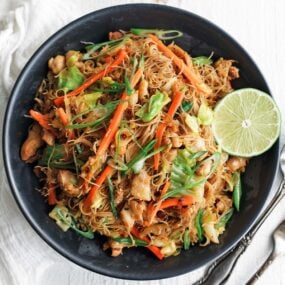

Pancit Recipe
This easy 30-minute Pancit combines chicken, pork, veggies, and noodles in a flavorful sauce—perfect for weeknights or parties.
Ingredients
- 4 tablespoons neutral-flavored oil
- 8 ounces pork shoulder, belly, or loin cut into ½” cubes
- 1 pound boneless chicken thighs, cut into 1” cubes, skin optional
- 1 peeled, julienne medium-sized yellow onion
- 7 to 8 finely minced garlic cloves
- ½ teaspoon ground achiote powder, optional
- 2 peeled, julienne medium-sized carrots, about 1 cup
- 2 ribs of celery, thinly sliced on a bias, about 1 cup
- 1 cup sugar snap peas, thinly sliced on a bias
- 4 cups green cabbage, cut into 1” pieces
- 3 tablespoons oyster sauce
- ½ teaspoon granulated sugar
- 3 tablespoons soy sauce
- 1 to 2 teaspoons fish sauce, optional
- 4 cups of chicken stock
- 8 ounces of vermicelli noodles
- coarse salt and freshly cracked pepper to taste
- lemon or lime juice, optional.
Instructions
- Add 2 tablespoons of oil to a large wok over medium-high heat and heat until it begins to smoke lightly. Place the pork in the pan, season with salt and pepper, and stir-fry until browned on all sides and cooked through. This will take about 3 to 4 minutes. Set it aside in a large bowl or platter.
- Next, pour in 1 more tablespoon of oil, add the chicken, season with salt and pepper, and cook for 2 to 3 minutes without stirring. Then, stir-fry for 3 to 4 minutes, until well-browned and cooked through. Set it aside with the pork.
- In the leftover rendered fat, add the onions, gently season with salt, and cook over low to medium heat for 10 to 12 minutes, stirring frequently, until they are browned and tender. Stir in the garlic and cook for only 30 to 45 seconds. Then, stir in the optional achiote powder and mix until well combined. Set it aside with the pork and chicken.
- Add the remaining oil, turn the heat to high, and add the carrots, celery, snap peas, and cabbage. Gently season with salt, then stir-fry for 90 seconds. Set it aside with the pork, chicken, onions, and garlic.
- In the wok over medium heat, add the oyster sauce, sugar, soy sauce, fish sauce, and chicken stock, and bring to a simmer.
- Once simmering, add the noodles and cook, stirring constantly, until they have absorbed all the liquid and are cooked, which takes about 3 to 4 minutes.
- Add the cooked meat and veggies to the wok and stir until combined.
- Garnish with a squeeze of lime or lemon juice, and optionally, sliced green onions.
Notes
Vermicelli noodles are exceptionally delicate, and leaving them on the heat too long will make them mushy. To prevent overcooking, keep the noodles moving in the simmering sauce. Cook them just until they absorb the liquid and become tender. If your noodles are still too dry after 3 to 4 minutes, add more stock and continue stirring until they are tender.
Practice mise en place: This dish moves very quickly, and it’s essential to have all your ingredients measured, chopped, and ready to go before you start cooking. You don’t want to be scrambling to cut meats, chop veggies, or open sauces mid-recipe.
Chop everything evenly: Try to slice your proteins into even, bite-sized pieces (½ to 1-inch cubes) and slice your veggies thinly to help them cook through evenly and quickly.
Trust the multi-step process: Overcrowding the pan with both the pork and chicken will cause the meat to steam instead of sear. For the best results, sear the proteins separately in a single layer to get a nice golden-brown crust. Also, take your time when caramelizing the onions, as this will slowly bring out their natural sweetness and add complexity to this noodle dish. Don’t rush this step!
Customize the ingredients and flavors: Pancit bihon is incredibly adaptable. You can easily substitute the chicken and pork with shrimp and steak, and use any vegetables you like or already have on hand in your fridge. Bok choy, bell peppers, green beans, mushrooms, and/or bean sprouts would all be delicious add-ins.
Skip the pork: You can make this dish using only chicken, but if you have a little extra pork on hand, this is a great recipe to use it in.
Make-Ahead: Pancit is best served immediately, as the noodles will become soggy if left to sit for too long. To get a head start, you can slice the vegetables and aromatics, cube the pork and chicken, and mix the sauce ingredients the day before. Keep all ingredients in airtight containers in the refrigerator until you’re ready to cook.
How to Store: Store the cooled pancit leftovers in an airtight container in the fridge for up to 3 days. It will also freeze well for up to 2 months. Just thaw the noodles overnight in the refrigerator before reheating.
How to Reheat: Toss the noodles in a skillet over medium heat with a splash of water or chicken stock to rehydrate the leftovers and restore their saucy texture.
Nutrition
Calories: 548kcalCarbohydrates: 53gProtein: 26gFat: 26gSaturated Fat: 5gPolyunsaturated Fat: 6gMonounsaturated Fat: 13gTrans Fat: 0.1gCholesterol: 94mgSodium: 1505mgPotassium: 956mgFiber: 4gSugar: 10gVitamin A: 535IUVitamin C: 48mgCalcium: 122mgIron: 4mg